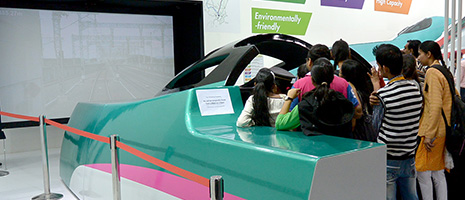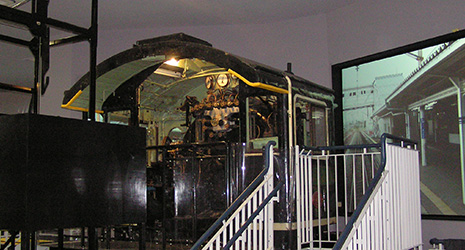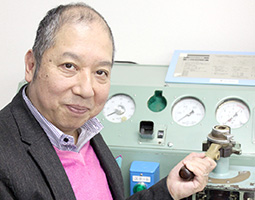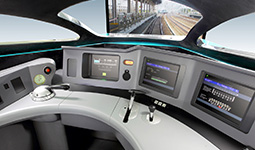Home > Highlighting JAPAN > Highlighting Japan April 2017 > The New Age of Rail
Highlighting JAPAN


The Cockpit Experience
State-of-the-art train simulators developed in Japan play a vital role in supporting railway safety.
The train simulator is a device that provides an image- and sound-based simulated experience of train operation. It is used not only for game content but also for training professional drivers. Tokyo-based Ongakukan Co. Ltd. is a producer of train simulators that create an operation environment that is very similar to the one in which a real train is operated. The company is highly rated both in Japan and abroad.
One of the features of the simulators produced by the company is a realistic image created through the combination of live-action images of running trains shot with the latest Hi-vision cameras and CG. It also recreates true-to-life changes in speed that occur due to the inclination of railroad tracks, deterioration in braking performance in rainy conditions and changes in the stability of vehicles due to load factors. In addition, it can randomly set up a situation in which an unexpected accident occurs.
“More than 100 situations are incorporated to help train drivers’ training, including falls from train platforms and breakdowns of vehicles and signals,” says Minoru Mukaiya, CEO of Ongakukan Co. “The simulator is designed to create different situations at random according to the purpose of the training so that drivers can improve their skills in dealing with emergencies more rapidly and appropriately.”
The company also attaches importance to sound recreation. The simulator recreates true-to-life sounds for each situation, such as the sound of motors generated by vehicles, the sound of vehicles when they pass over the joints of railroad tracks and the Doppler effect generated by alarm sounds when trains drive through railroad crossings. Moreover, by fine-tuning the sound waveforms according to the traveling speed of a vehicle, it even recreates the difference between a situation in which two vehicles are moving in opposite directions at accelerated speed and one in which they are traveling due to inertia.
“We humans have a very keen sense of hearing,” says Mukaiya. “Sound is more important than images in pursuing the creation of realistic feelings.”
There is a reason why Mukaiya pays such close attention to sound. He is well known as the ex-keyboard player of Casiopea, an influential Japanese fusion band that formed in 1977. Mukaiya continues to enjoy a career as an active musician even today.
He did not want to live his life solely as a musician, however, and established Ongakukan Co. in 1985 as a company that leases recording materials for business use. Mukaiya, who has been a major railway fan since childhood, sold a train operation simulation game using live-action images in 1995. The huge success of the game led to the subsequent development of simulators for driver training.
Ongakukan’s simulators are also exhibited for ordinary people to enjoy. For example, the simulator for the D51, one of the most popular Japanese steam locomotive trains, is exhibited along with trains used for the Keihintohoku and Takasaki Lines in the Railway Museum in Saitama City, Saitama Prefecture. The simulator for the D51, which is equipped with dual 150-inch screens, recreates the operation and vibrations that are unique to locomotive trains.
Ongakukan-produced simulators attract interest overseas as well. The simulator for the E5 series of the Tohoku Shinkansen produced by the company was exhibited at the booth of East Japan Railway Company (JR East) at InnoTrans, an international trade fair of railway technologies that was held in Berlin in September 2014.
The simulator perfectly recreates the function of the DS-ATC, a digital automatic train control system used in the Shinkansen service of JR East. It incorporates six situations, including the application of emergency brakes in the event of an earthquake, and supports two languages: Japanese and English. The simulator garnered so much attention that people waited for two hours to see the product at the trade fair. Drivers of the TGV, France’s high-speed train service, and Germany’s ICE also experienced the simulated operation of the Shinkansen. They were impressed with the high safety performance of the service. Subsequently, the E5 simulator was displayed in exhibitions held in different countries around the world, including Malaysia, India, Singapore and the United States. It was also one of the most featured items at the World Congress on High Speed Rail that was held in Tokyo in July 2015.
“The Japanese railway service has a significant advantage in terms of safety. This is supported by the high skill level of the drivers, as well as systems such as signaling,” says Mukaiya. “As a producer of simulators that help drivers to develop, we will continue to support railway safety and Japanese railway operators and vehicle manufacturers as they expand their business overseas going forward.”
© 2009 Cabinet Office, Government of Japan








